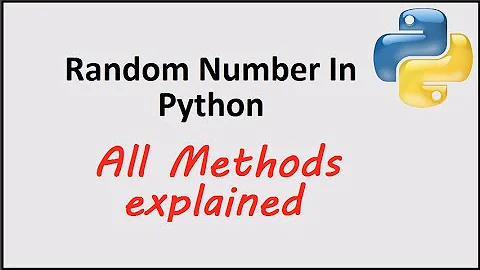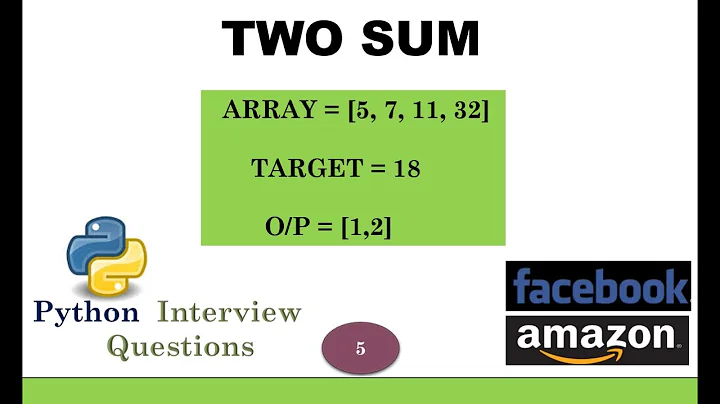How to generate random pairs of numbers in Python, including pairs with one entry being the same and excluding pairs with both entries being the same?
Solution 1
Generator random unique coordinates:
from random import randint
def gencoordinates(m, n):
seen = set()
x, y = randint(m, n), randint(m, n)
while True:
seen.add((x, y))
yield (x, y)
x, y = randint(m, n), randint(m, n)
while (x, y) in seen:
x, y = randint(m, n), randint(m, n)
Output:
>>> g = gencoordinates(1, 100)
>>> next(g)
(42, 98)
>>> next(g)
(9, 5)
>>> next(g)
(89, 29)
>>> next(g)
(67, 56)
>>> next(g)
(63, 65)
>>> next(g)
(92, 66)
>>> next(g)
(11, 46)
>>> next(g)
(68, 21)
>>> next(g)
(85, 6)
>>> next(g)
(95, 97)
>>> next(g)
(20, 6)
>>> next(g)
(20, 86)
As you can see coincidentally an x coordinate was repeated!
Solution 2
Let's say that your x and y coordinates are all integers between 0 and n. For small n a simple method might be to generate the set of all possible xy coordinates using np.mgrid, reshape it to a (nx * ny, 2) array, then sample random rows from this:
nx, ny = 100, 200
xy = np.mgrid[:nx,:ny].reshape(2, -1).T
sample = xy.take(np.random.choice(xy.shape[0], 100, replace=False), axis=0)
Creating the array of all possible coordinates can become expensive if nx and/or ny is very large, in which case it might be better to use a generator object and keep track of previously used coordinates, as in James' answer.
Following @morningsun's suggestion, an alternative method is to sample from the set of nx*ny indices into the flattened array then convert these directly to x, y coordinates, which avoids constructing the whole nx*ny array of possible x, y permutations.
For comparison, here's a version of my original approach generalized for N-dimensional arrays, plus a version that uses the new approach:
def sample_comb1(dims, nsamp):
perm = np.indices(dims).reshape(len(dims), -1).T
idx = np.random.choice(perm.shape[0], nsamp, replace=False)
return perm.take(idx, axis=0)
def sample_comb2(dims, nsamp):
idx = np.random.choice(np.prod(dims), nsamp, replace=False)
return np.vstack(np.unravel_index(idx, dims)).T
There's not a huge difference in practice, but the benefits of the second method become a bit more apparent for larger arrays:
In [1]: %timeit sample_comb1((100, 200), 100)
100 loops, best of 3: 2.59 ms per loop
In [2]: %timeit sample_comb2((100, 200), 100)
100 loops, best of 3: 2.4 ms per loop
In [3]: %timeit sample_comb1((1000, 2000), 100)
1 loops, best of 3: 341 ms per loop
In [4]: %timeit sample_comb2((1000, 2000), 100)
1 loops, best of 3: 319 ms per loop
If you have scikit-learn installed, sklearn.utils.random.sample_without_replacement offers a much faster method for generating random indices without replacement using Floyd's algorithm:
from sklearn.utils.random import sample_without_replacement
def sample_comb3(dims, nsamp):
idx = sample_without_replacement(np.prod(dims), nsamp)
return np.vstack(np.unravel_index(idx, dims)).T
In [5]: %timeit sample_comb3((1000, 2000), 100)
The slowest run took 4.49 times longer than the fastest. This could mean that an
intermediate result is being cached
10000 loops, best of 3: 53.2 µs per loop
Solution 3
@James Miles answer is great, but just to avoid endless loops when accidentally asking for too many arguments I suggest the following (it also removes some repetitions):
def gencoordinates(m, n):
seen = set()
x, y = randint(m, n), randint(m, n)
while len(seen) < (n + 1 - m)**2:
while (x, y) in seen:
x, y = randint(m, n), randint(m, n)
seen.add((x, y))
yield (x, y)
return
Note that wrong range of values will still propagate down.
Related videos on Youtube
Dave
Updated on September 15, 2022Comments
-
Dave over 1 year
I'm using Python and was using numpy for this. I want to generate pairs of random numbers. I want to exclude repetitive outcomes of pairs with both entries being the same number and I want to include pairs which only have one entry being the same number.I tried to use
import numpy numpy.random.choice(a,(m,n),replace=False)for it, but it excludes any tupels with the the same entries completely, i.e.
import numpy numpy.random.choice(a=2,(m=2,n=1),replace=False)gives me only (1,0) and (0,1) and not (1,1), (0,0), (1,0) and (0,1).
I want to do this because I want to draw a sample of random tuples with a large a and large n(as used above) without getting exactly the same tupels more then once. It also should be more or less efficient. Is there a way that's already implemented to do this?
-
Tim Pietzcker almost 9 yearsI've read this three times, and I still don't get it. If you want to exclude pairs where both entries are the same number, then you should exclude (1,1) and (0,0) - could you explain why you're unhappy with the result you have?
-
James Mills almost 9 yearsThen don't you just want a generator to generate a random pair of unique
(x, y)coordinates?
-
-
Dave almost 9 yearsI'll check back on this later, got a group meeting now. Thank you a lot already for the quick answer
-
Dave almost 9 yearsI implemented lines/the idea of your code and for excercise did my own. Thank you again.
-
 Admin over 8 yearsI thought a random choice of the linear indices would be better, but in practice it's not faster. A limitation of the current numpy.
Admin over 8 yearsI thought a random choice of the linear indices would be better, but in practice it's not faster. A limitation of the current numpy.










